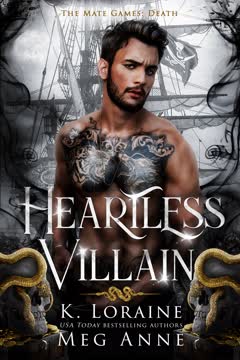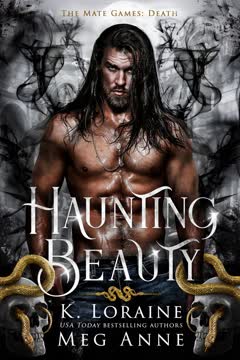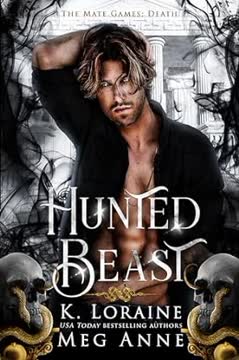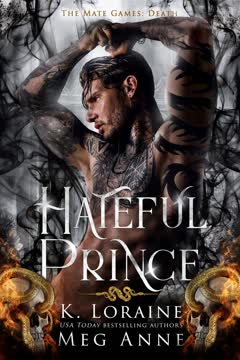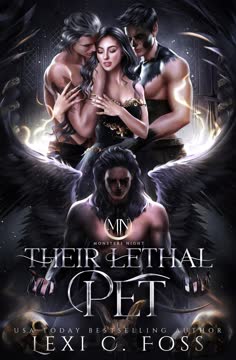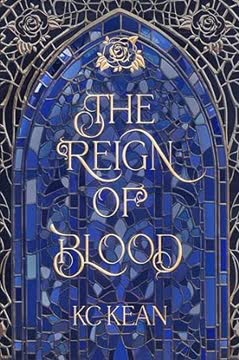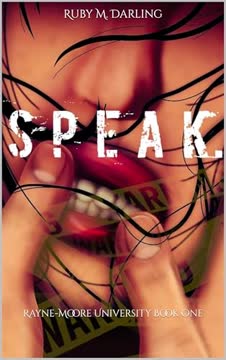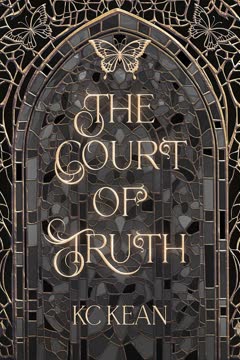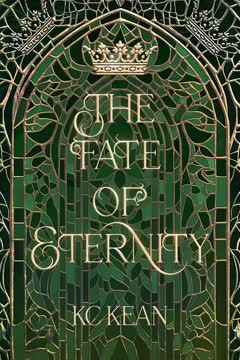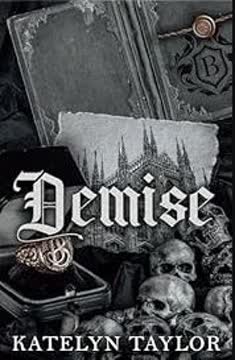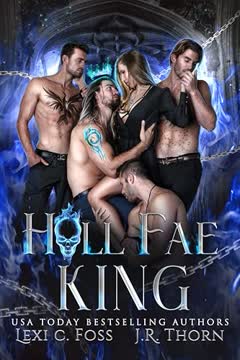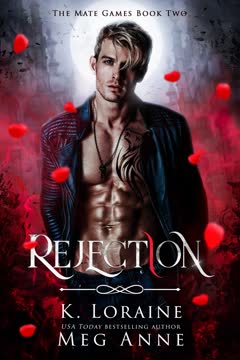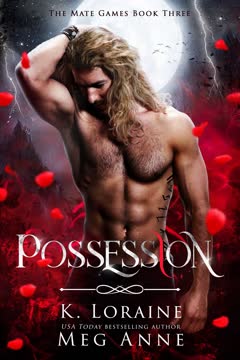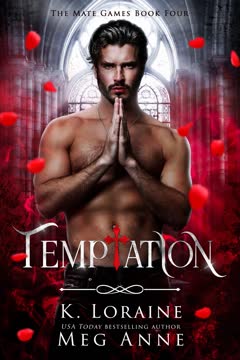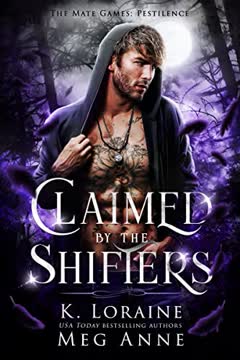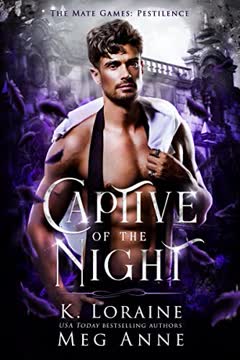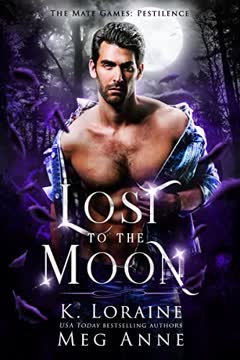Plot Summary
Blood and Fire Awakening
Dahlia teeters on the edge of death after a brutal attack, her blood soaking the altar of a dark ritual. Her mates—Tor, Hades, Caspian, and Kai—fight desperately to save her, each revealing their own brand of devotion and fear. As her life slips away, Kai's dragon is unleashed in a blaze of vengeance, scorching the night and turning the tide. The group's bond is tested by trauma and the raw, primal need to protect. Dahlia's survival is bought with sacrifice, magic, and the first taste of the supernatural unity that will define their journey. The emotional stakes are set: love, loss, and the promise that no one will be left behind.
Dragon Unleashed, Bonds Forged
Kai's dragon, once imprisoned within a sentient tattoo, is finally freed, merging his two halves into a formidable whole. Dahlia recovers, her wounds healed by the blood of a vampire priest, and the group's relief is palpable. The mates share moments of vulnerability and humor, their banter masking the deep scars left by recent violence. Christmas arrives, bringing with it gifts that symbolize their growing connection—rings, journals, and the promise of magical tattoos to bind their souls. The chapter pulses with hope, desire, and the tentative steps toward healing, even as shadows linger at the edges of their newfound peace.
Pirate's Heart, Christmas Light
Caspian, the rakish pirate, orchestrates a Christmas celebration that becomes a sanctuary for the wounded group. The holiday is a tapestry of laughter, gifts, and confessions, each mate offering Dahlia a piece of themselves. Caspian's vulnerability is laid bare through a hypnotic tape, revealing his fear of unworthiness and his desperate longing for love. The group's dynamic is playful yet charged, their physical and emotional intimacy deepening. Amidst the festivities, the specter of trauma lingers, but the warmth of found family offers a fragile shield. The chapter is a testament to the power of found family and the healing that comes from being truly seen.
Gifts, Promises, and Scars
Kai's magical tattoos become the literal and figurative mark of the group's commitment, binding their souls and granting them the ability to sense and protect one another. The ritual is intimate, blending pain and pleasure, and each mate's unique power is woven into the spell. The process exposes their deepest desires and insecurities, but also their willingness to sacrifice for Dahlia and each other. The tattoos are more than art—they are a promise of unity in the face of coming darkness. The chapter is charged with eroticism, vulnerability, and the unspoken fear that even magic may not be enough to keep them safe.
Shadows, Trust, and Surrender
The group explores the boundaries of trust and desire, pushing Dahlia to surrender control in ways that both terrify and exhilarate her. Scenes of restraint, dominance, and shared pleasure become a crucible for their emotional bonds. Each mate reveals a different facet of love—Tor's protectiveness, Hades's darkness, Caspian's playfulness, Kai's primal need. The interplay of power and vulnerability is both erotic and healing, allowing Dahlia to reclaim agency over her body and her fears. The chapter is a dance of shadows and light, where surrender becomes strength and love is proven through action.
Secrets, Sacrifice, and Survival
Dahlia's best friend Kiki becomes a lifeline to the outside world, her irreverent humor and fierce loyalty a balm for Dahlia's isolation. But secrets fester—about Blackwood's true nature as a prison, about the supernatural politics that keep them trapped, and about the darkness lurking within the estate. The group's unity is tested by the weight of what they cannot say, and the realization that survival may require impossible choices. The chapter is a meditation on the cost of secrecy, the pain of separation, and the hope that even in captivity, love and friendship can endure.
Ghosts, Grudges, and Revelations
Dahlia's necromantic powers draw the attention of restless spirits, each with their own grudges and unfinished business. Her attempts to help them become a mirror for her own struggles with identity and purpose. The ghosts are both literal and metaphorical—manifestations of guilt, trauma, and the fear of becoming a villain. Through these encounters, Dahlia begins to accept her power, questioning whether she can use it for good or if she is doomed to repeat the sins of her father. The chapter is a haunting exploration of legacy, redemption, and the courage to face the darkness within.
Brothers Torn, Truths Unveiled
Tor's twin brother Alek arrives, forcing Tor to confront the consequences of his self-imposed exile and the curse he bears in Alek's place. Their reunion is fraught with anger, love, and the unspoken pain of choices made for family. The truth of Tor's sacrifice is revealed, shattering illusions and forcing both brothers to reckon with the cost of love. The chapter is a raw examination of sibling bonds, the weight of destiny, and the agony of letting go. In the end, Tor chooses his found family, even as it means severing ties with the past.
Angelic Warnings, Mortal Threats
The angel Gabriel appears, delivering cryptic warnings and offering each mate a chance to escape the coming apocalypse by abandoning Dahlia. Each refuses, choosing love over safety, even as Gabriel's words foreshadow disaster. The threat of war grows as the villagers outside Blackwood, driven by fear and superstition, prepare to storm the estate. The chapter is a tense prelude to battle, where prophecy and free will collide, and the mates' choices set the stage for the ultimate test of their bond.
Madness, Glamour, and Gathering Storm
Caspian's struggle with madness intensifies, his mind fraying under the weight of whispers and ticking clocks. Yet when the estate is threatened, he becomes the unlikely leader, using his fae glamour to rally the scattered residents and staff. The group's unity is forged in crisis, their individual strengths coalescing into a force capable of withstanding the coming storm. The chapter is a study in resilience, the power of leadership born from vulnerability, and the desperate hope that together, they can survive what's to come.
Necromancer's Choice, Death's Daughter
Dahlia's true heritage is revealed—she is the daughter of Death, created as a pawn in an apocalyptic game. The revelation shatters her, forcing her to confront the possibility that her very existence may doom the world. Her mates rally around her, refusing to let her sacrifice herself, even as the lines between hero and villain blur. The chapter is a crucible of identity, where the burden of power is both a curse and a gift, and the only way forward is through acceptance and love.
War at Blackwood's Gates
The villagers attack, and Blackwood becomes a battlefield. The mates fight with everything they have—dragon fire, shadows, steel, and magic—each sustaining wounds that threaten to break them. Dahlia, desperate to save them, unleashes her necromantic scream, killing friend and foe alike. The aftermath is devastation: bodies litter the grounds, and the cost of survival is measured in blood and grief. The chapter is a harrowing meditation on the price of love, the horror of war, and the thin line between savior and destroyer.
Screams, Sacrifice, and Loss
Kiki is killed in the chaos, her death a wound that nearly breaks Dahlia. In her grief, Dahlia attempts to resurrect her, but learns the limits of her power—only those she herself has slain can be returned. The lesson is brutal: some losses cannot be undone, and the dead must be allowed to rest. The mates comfort Dahlia, their own wounds raw, as they face the reality that even magic cannot shield them from pain. The chapter is a requiem for friendship, a lesson in letting go, and a testament to the enduring power of love.
Death's Gambit, Apocalypse Rises
The true villain is unmasked: Death, masquerading as Dr. Masterson, has orchestrated every move, manipulating Dahlia and her mates into fulfilling an apocalyptic ritual. Dahlia is crucified, her power siphoned to open a portal and fuel Death's ascension. The horsemen of the apocalypse are revealed as fellow prisoners, their energy stolen to complete the spell. The mates, aided by Gabriel, mount a desperate rescue, confronting Death in a final, cataclysmic battle. The chapter is a crescendo of betrayal, sacrifice, and the ultimate test of loyalty.
Bonds Broken, Bonds Remade
The mates shatter Death's ritual, freeing Dahlia and the horsemen, but not without cost. The bonds that held them together are tested and reforged in the crucible of battle. The aftermath is bittersweet—victory is won, but the scars remain. The world is saved, but the threat of apocalypse lingers, and the group must reckon with the knowledge that their love is both a shield and a weapon. The chapter is a meditation on resilience, the power of found family, and the promise that together, they can face whatever comes next.
Aftermath, Forgiveness, and Farewell
In the quiet after the storm, the group mourns their losses and begins the slow work of healing. Tor reconciles with his brother, old wounds are acknowledged and forgiven, and the mates reaffirm their commitment to one another. Dahlia is reunited with Kiki in the underworld, finding solace in the knowledge that love endures beyond death. The chapter is a gentle coda, a reminder that even in the wake of apocalypse, life—and love—goes on.
Underworld Reunion, New Beginnings
Dahlia and her mates journey to the underworld, where they are welcomed as family. The realm is a place of peace and possibility, a sanctuary where old wounds can heal and new dreams can take root. Kiki finds her own happy ending, and the group looks to the future with hope. The story closes on the promise of adventure, the certainty of love, and the knowledge that, together, they can weather any storm. The emotional arc is complete: from trauma and loss to healing and the promise of forever.
Characters
Dahlia Moore
Dahlia is the emotional and narrative heart of the story—a woman marked by trauma, loss, and the burden of supernatural power she never asked for. Her journey is one of self-discovery, as she moves from victim to agent, learning to wield her necromancy not as a curse but as a tool for justice and healing. Her relationships with her mates are complex, blending desire, vulnerability, and fierce loyalty. Dahlia's greatest fear is becoming the villain of her own story, a fear manipulated by those who would use her for their own ends. Yet, through love, friendship, and the acceptance of her true heritage as Death's daughter, she finds the strength to choose her own destiny. Her arc is one of reclamation—of power, agency, and the right to define herself.
Tor Nordson
Tor is a demigod and Berserker, haunted by the curse he bears in place of his twin brother. His love for Dahlia is both a balm and a torment, as he struggles with the fear of losing control and harming those he loves. Tor's journey is one of sacrifice—he gives up his past, his family, and his very identity to protect others. His relationship with his mates is marked by rivalry and camaraderie, but his devotion to Dahlia is unwavering. Tor's arc is about learning to forgive himself, to accept love even when he feels unworthy, and to find peace in the family he chooses.
Malakai "Kai" Nash
Kai is a fae dragon shifter, marked by the trauma of having his dragon imprisoned within a sentient tattoo. His journey is one of integration—reconciling the beast within with the man he wants to be. Kai's love for Dahlia is primal and protective, but also deeply tender. He is the group's healer, both literally and figuratively, using his magic to bind and protect. Kai's arc is about embracing his full self, finding strength in vulnerability, and learning that true power comes from unity, not isolation.
Caspian "Hook"
Caspian is a high-born fae pirate, his mind fraying under the weight of madness and the ticking of an unseen clock. His bravado masks a deep fear of unworthiness and abandonment. Caspian's journey is one of redemption—proving to himself and others that he is more than a villain, that he is capable of love and loyalty. His glamour is both a weapon and a curse, and his leadership is born from vulnerability. Caspian's arc is about finding home in others, accepting help, and choosing to fight for something greater than himself.
Hades (Cain Alexander)
Hades is the god of the underworld, his power rooted in death and shadow. His love for Dahlia is ancient, spanning lifetimes, and marked by both possessiveness and devotion. Hades's journey is one of letting go—of past wounds, of the need for control, and of the fear that love will always end in loss. He is both protector and tempter, his darkness a mirror for Dahlia's own. Hades's arc is about learning to trust, to share power, and to accept that even gods are not immune to pain or change.
Kiki
Kiki is Dahlia's best friend and lifeline to the mortal world. Her irreverent humor and unwavering loyalty provide both comic relief and emotional grounding. Kiki's arc is one of sacrifice—she risks everything to help Dahlia, ultimately paying the ultimate price. Even in death, her presence is a source of comfort and hope, reminding Dahlia that love endures beyond the grave.
Dr. Elizabeth Masterson / Death
Masterson is the story's central antagonist, a master manipulator who orchestrates every move to bring about the apocalypse. Her dual identity as Death and Dahlia's mother adds layers of betrayal and tragedy. Masterson's arc is one of ambition and hubris—believing she can control fate, only to be undone by the very love and loyalty she sought to exploit. Her legacy is a warning about the dangers of unchecked power and the cost of playing god.
Alek Nordson
Alek is Tor's twin, his presence a constant reminder of the life Tor sacrificed. Their relationship is fraught with love, resentment, and the pain of choices made for family. Alek's arc is about forgiveness—of himself, of Tor, and of the past that binds them. He represents the ties of blood, both a source of strength and a chain to be broken.
Gabriel
Gabriel is the angelic messenger, delivering warnings and offering escape in exchange for sacrifice. His role is both adversarial and redemptive, challenging the mates to choose between love and duty. Gabriel's arc is about the limits of intervention, the cost of prophecy, and the recognition that even angels cannot dictate the choices of mortals.
Sorcha Blackthorne
Sorcha is a vampire resident of Blackwood, her cynicism and survival instincts a foil to Dahlia's hope. Her arc is about learning to trust, to fight for something beyond herself, and to accept that even in a world of monsters, there is room for loyalty and love.
Plot Devices
Multi-POV, Found Family, and Erotic Bonding
The narrative structure employs multiple points of view, allowing readers to inhabit the minds and hearts of each major character. This deepens emotional resonance and reveals the unique fears, desires, and motivations that drive the group. The found family trope is central—each mate is broken in their own way, but together they form a whole greater than the sum of its parts. Erotic bonding rituals (tattoos, shared power, physical intimacy) serve as both plot and character development, literalizing the theme that unity is strength. The story uses transcripts, therapy sessions, and supernatural interviews as framing devices, offering both exposition and psychological insight. Foreshadowing is woven through angelic warnings, ghostly hauntings, and the ever-present threat of apocalypse, building tension and a sense of inevitability. The climax employs the classic "final battle" structure, but subverts expectations by making the true enemy not an external force, but the legacy of trauma, manipulation, and the fear of becoming a villain.
Analysis
Heartless Villain is a genre-bending blend of paranormal romance, reverse harem, and dark fantasy, but at its core, it is a story about reclaiming agency in the face of trauma and manipulation. Dahlia's journey from victim to necromancer, from pawn to player, is a powerful metaphor for the struggle to define oneself against the expectations and wounds of the past. The mates—each broken, each dangerous—are not saviors, but partners in healing, their love both a source of strength and a crucible for growth. The book interrogates the line between hero and villain, asking whether power can ever be used for good, or if all agency is tainted by the legacy of violence. The use of erotic bonding and found family is not just titillation, but a radical assertion that intimacy and vulnerability are acts of resistance. The story's willingness to kill beloved characters, to let love be both a shield and a weapon, and to leave the door open for future apocalypse, marks it as a work unafraid of consequence. Ultimately, Heartless Villain is a celebration of survival—not as a return to innocence, but as the forging of something new and fiercely, unapologetically alive.
Last updated:
Review Summary
Heartless Villain receives mostly positive reviews, with readers praising the spicy content, engaging characters, and satisfying conclusion to the series. Many enjoy the full-cast audiobook narration, finding it enhances the experience. Some criticize the rushed ending and underdeveloped plot. Readers appreciate the humor, crossover references, and character development. While opinions on individual characters vary, most find the overall series entertaining. Some express disappointment in having to wait until 2025 for the next installment.
The Mate Games: Death Series
Similar Books
Download PDF
Download EPUB
.epub digital book format is ideal for reading ebooks on phones, tablets, and e-readers.
